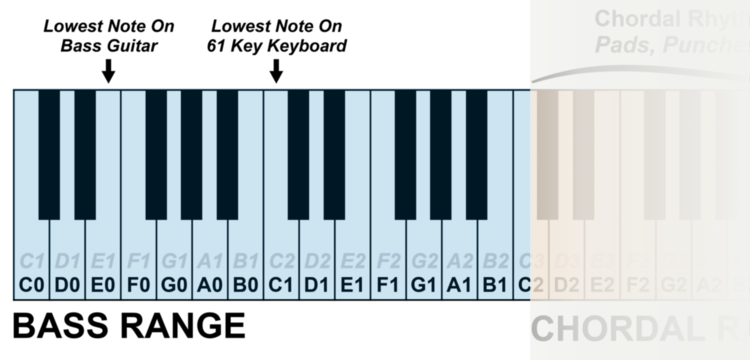production through performance
Learn
3.3 Original progression
The bass instrument mostly plays the root (letter name) of each chord in a progression. Applying the rhythmic relationship of the bass and kick along with these pitches creates a bass line.
Watch the walkthrough video.
Learn the information below.
BASS RANGE
The bass sounds best between C0 and C2 on the piano keyboard. Depending on the size of the keyboard that you are playing, you might need to transpose it an octave down.
Diatonic Chords
The qualities of chords and their locations in a major scale are the same in every key. To show the location and the qualities of chords Roman Numerals are used; major chords are capital, minor chords are lower case, and diminished chords are lower case with a degree symbol. The I IV and V chords are major, the ii iii and vi chords are minor, and the vii chord is diminished in every key.
DIATONIC CHORD PROGRESSIONS
A chord progression is a sequence of chords. Chord progressions can be written following simple rules. Learn what each chord progression sounds like by experimenting with progressions that you write. Learn how to write chord progressions using these rules and the the chord progression template on THIS PAGE →
Compose
1 WRITE AN ORIGINAL CHORD PROGRESSION
Write a four chord progression in the key of C
Use the Chord Progression Page →
Write what you like in the Chord Progression Organizer →
Copy the progression to the Bass Line Organizer →
2 WRITE AND RECORD A DRUM GROOVE
Create a four measure drum groove using either 8th or 16th note subdivision by listening to the rap loop.
Write the drum groove down on the organizer.
Record the drum groove and quantize the performance to the correct subdivision
3 FIND A GOOD SOUND
Add a new track -> bass & 808 track. Find an 808 sound that has enough punch to cut through the mix.
4 DETERMINE THE RHTYHM
Use a rhythm that matches the kick in the drum groove. Copy the rhythm and chord progression down on the organizer.
5 ADD DURATION
Figure out the best length for each note. Remember that the ends of notes in a bass line are almost as important as the attacks. Log the note lengths in the organizer.
Practice
6 PREPARE TO RECORD
Practice playing the bass line to make it easier to record. Follow these tips to ensure you will have a positive recording experience.
Play the roots of each chord with the left hand without the recording until it is easy to move from chord to chord.
Count and play the rhythm of the bass line with a metronome at a slower tempo.
Slowly speed up the tempo until it is easy to play.
Practice along with the recording until the part is in muscle memory.
Record
7 RECORD
Know the expectations! Review the Rubric →
Record the bass line along with the drum groove and rap track.
Make sure the metronome is on and audible.
Feel the groove in your body while performing.
Quantize the attacks of each note.
Trim the ends of note to match the organizer.
Reflect on how you did with the Self Assessment →
Extend
8 EXTEND | OCTAVE JUMPS & LEADING TONES
Add octave jumps and leading tones to your bass line.
Learn about the different bass line motion types with the animations below.
Add in octave jumps and/or leading tones by editing the pitches on the piano roll.
These notes can also be added by re-recording the bass line.
Use the pinky of your left hand to play lower roots and the thumb of your left hand to play octave jumps.
Bass Motion Types
ROOTS IN THE SAME OCTAVE
The roots for each chord are played with the kick drum. There is no motion within the measure.
OCTAVE JUMP
The root moves up or down by an octave (same pitch that is one scale length away). Octave jumps sound best when they are kept in the bass range.
LEADING TONES
A leading tone is a note(s) that is one letter above or below the note you are going to. Leading tones should be used on weak beats. More than one leading tone can be used together to create even more stepwise motion.
OCTAVE JUMPS AND LEADING TONES
Octave jumps and leading tones can be used together to create highly dynamic bass lines. These mechanisms can be used separately within the measure or they can be combined.
ie. A leading tone can be used in conjunction with an octave jump.

